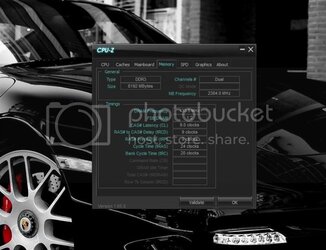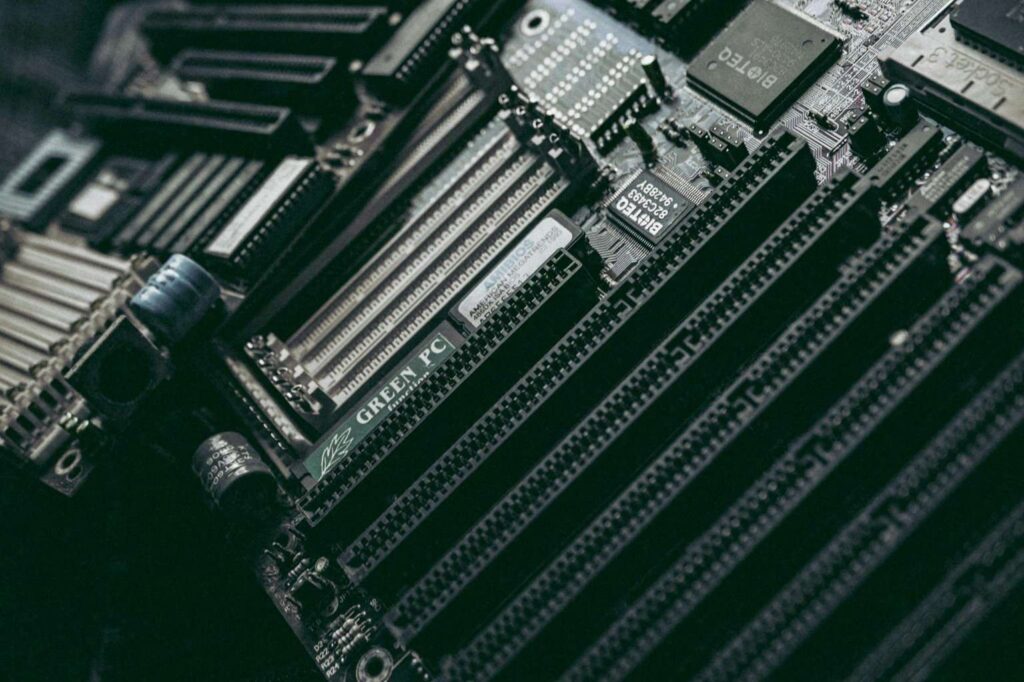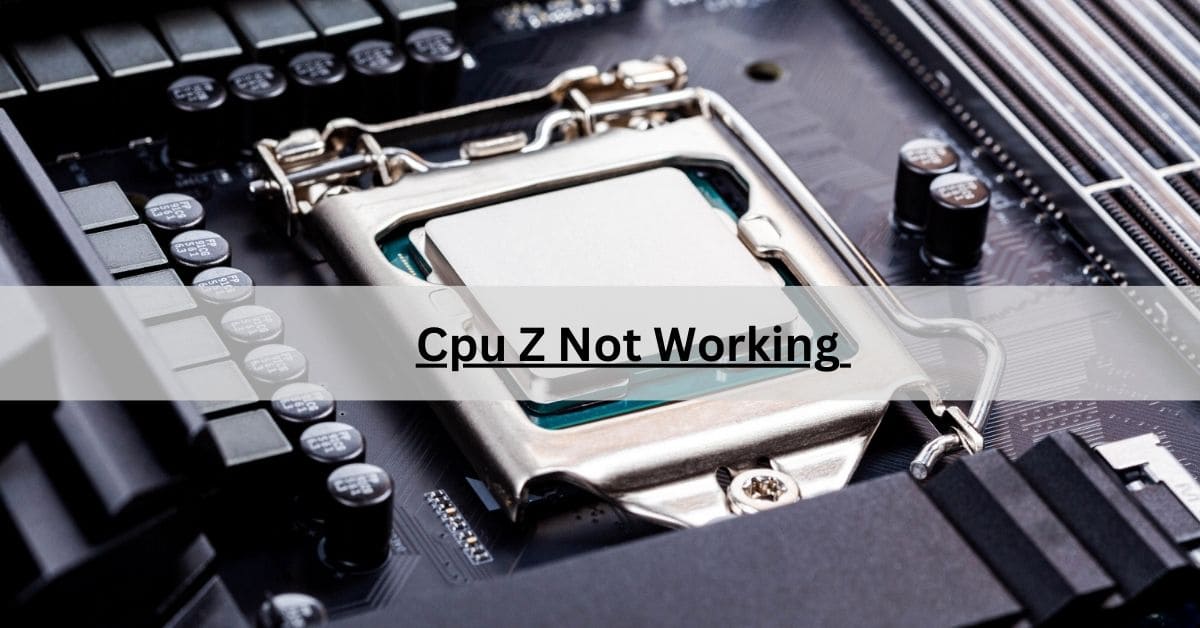Recently, I ran into an issue with CPU-Z not working properly—it just wouldn’t open no matter what I tried. After a bit of troubleshooting, I found that updating my drivers and running CPU-Z as an administrator fixed the problem.
If CPU-Z isn’t working or won’t open, don’t worry—simple fixes can get it running smoothly again. Often, updating drivers, running it as an administrator, or reinstalling the app solves the issue. Here’s a quick guide to troubleshoot and fix CPU-Z!
In this article, we will discuss all about “Cpu Z Not Working ”
Why Is CPU-Z Not Working on My PC?

CPU-Z might not be working on your PC due to a few common issues. Sometimes, it’s as simple as needing to update your drivers, which help your hardware and software communicate properly. Outdated or incompatible drivers can stop CPU-Z from reading your system’s details. Another reason could be a corrupted installation file—if CPU-Z didn’t install correctly, it may not open or work right.
Read More: Can Cpu Run Without Thermal Paste – Expert
How Do I Fix CPU-Z Not Opening?
1. Run as Administrator:
Running a program as an administrator gives it special permissions to make changes on your computer that normal programs can’t. To do this, right-click the program icon, then select “Run as Administrator.” This often helps fix issues with programs like CPU-Z, as it allows them to access the system resources they need to work properly.
2. Update Drivers:
Updating drivers means installing the latest software that helps your computer’s hardware (like the CPU, graphics card, or sound card) work correctly with other programs and devices. Manufacturers release updates to improve performance, fix bugs, or add new features. To update, you can go to your computer’s “Device Manager,” find the hardware you want to update, and select “Update driver.”
3. Disable Antivirus Temporarily:
To temporarily disable your antivirus, start by finding the antivirus icon on your computer (usually in the lower-right corner of the screen or in the system tray). Right-click on the icon and look for an option like “Pause Protection,” “Turn Off Protection,” or “Disable Antivirus.” Select this option, and you may be asked how long you want it to stay off—choose the shortest time you need.
4. Reinstall CPU-Z:
To reinstall CPU-Z, first, go to the Control Panel on your computer and uninstall the current version of CPU-Z. Once it’s removed, visit the official CPU-Z website to download the latest version. After downloading, open the setup file and follow the on-screen instructions to install it again. This can help fix issues like crashes or errors by giving you a fresh, updated version of the app.
Why Does CPU-Z Keep Crashing?
- Outdated Drivers: If your hardware drivers, especially the CPU or chipset drivers, are outdated, it can cause CPU-Z to crash.
- Software Conflicts: Other programs, particularly antivirus or monitoring software, can interfere with CPU-Z and lead to crashes.
- Corrupted Installation: A corrupt installation or missing files might cause the application to crash when you try to run it.
- Compatibility Issues: CPU-Z might not be fully compatible with your operating system or hardware, especially if you’re using a very old or beta version.
Can Outdated Drivers Cause CPU-Z to Stop Working?
1. Incompatibility with Newer Versions:
Sometimes, CPU-Z may not work properly because it’s not compatible with the latest version of your operating system or hardware. This can happen when a newer version of Windows or a new CPU doesn’t match well with the older CPU-Z software. In such cases, updating CPU-Z to the latest version or checking for any available patches can help resolve compatibility issues and make it work smoothly again.
2. Incorrect Hardware Detection:
Incorrect hardware detection happens when a program like CPU-Z shows wrong information about your computer’s hardware. This could mean it doesn’t identify your CPU, RAM, or motherboard correctly, or it may show outdated or missing details. This issue can happen due to outdated drivers, incompatible software, or settings on your system.
3. System Instability:
System instability means your computer or device isn’t working properly and may crash, freeze, or show errors. This can happen when software, drivers, or hardware aren’t working together well. It may cause programs to close unexpectedly or the whole system to slow down. To fix instability, you might need to update software, check for viruses, or repair hardware.
What Should I Do if CPU-Z Won’t Respond?
If CPU-Z won’t respond, try a few simple steps to fix it. First, make sure your computer’s drivers are up to date, especially for your CPU and chipset. Then, try running CPU-Z as an administrator by right-clicking the program and selecting “Run as Administrator.” If it still doesn’t work, try reinstalling CPU-Z or checking for any software conflicts. These steps should help get CPU-Z running again!
Why Is CPU-Z Stuck on Loading?
If CPU-Z is stuck on loading, it could be due to several reasons. The program might be having trouble reading your system information, or there could be a problem with outdated drivers or software conflicts. Try restarting your computer to clear any temporary issues, then update your drivers and make sure there’s no antivirus software blocking CPU-Z. If the issue persists, reinstalling the program might help fix the problem.
How Do I Reinstall CPU-Z to Fix Problems?

To reinstall CPU-Z and fix any problems, first, uninstall the current version from your computer. You can do this by going to “Control Panel,” then “Programs,” and selecting CPU-Z to uninstall it. Once removed, visit the official CPU-Z website to download the latest version. After downloading, simply follow the installation steps to reinstall the program. This fresh install should help solve any issues you were facing with CPU-Z.
Read More: Can You Flash Bios With Cpu Installed – Find Out Now!
How Can I Fix CPU-Z Not Detecting My CPU?
If CPU-Z isn’t detecting your CPU, try a few things to fix it. First, make sure your CPU drivers are up to date by checking the manufacturer’s website or using a driver update tool. Next, try restarting your computer to refresh the system. If that doesn’t work, make sure your system’s BIOS is up to date, as an outdated BIOS can cause detection issues.
Does Windows Update Affect CPU-Z Functionality?
Yes, a Windows update can sometimes affect how CPU-Z works. Updates may change system settings, drivers, or security features that can interfere with CPU-Z’s ability to read your hardware information correctly. If you notice CPU-Z not working properly after a Windows update, try updating your drivers, check for any system conflicts, or roll back the update to see if it resolves the issue.
Why Does CPU-Z Show Incorrect Information?
1. Outdated or Incorrect Drivers:
Outdated or incorrect drivers are programs that help your computer’s hardware, like your CPU or graphics card, communicate with the operating system. If these drivers are old or not properly installed, your hardware might not work correctly, causing issues like slow performance, crashes, or devices not being detected.
2. BIOS Issues:
BIOS issues happen when there are problems with the basic software that helps your computer start up. The BIOS controls important settings like how your hardware works together. If there’s an issue, your computer might not boot properly or could show error messages. Sometimes, outdated BIOS versions or incorrect settings can cause these problems. T
3. Overclocking:
Overclocking is the process of making your computer’s CPU or GPU run faster than its default speed. By increasing the clock speed, you can boost performance, making your computer faster for tasks like gaming or video editing. However, overclocking can cause your system to heat up more, so it’s important to make sure your cooling system is strong enough to handle the extra speed.
4. Software Conflicts:
Software conflicts happen when two or more programs on your computer interfere with each other, causing errors or making your system slow or unstable. This can occur when programs try to use the same resources or settings, or when one program isn’t compatible with another. To fix software conflicts, you can try updating or reinstalling the programs, or even disabling unnecessary programs running in the background.
5. Hardware Problems:
Hardware problems refer to issues with the physical parts of your computer, like the motherboard, CPU, RAM, or hard drive. These problems can cause your computer to freeze, crash, or not start at all. Common signs of hardware problems include strange noises, error messages, or performance issues. To fix hardware problems, you might need to replace faulty parts or check connections to make sure everything is working properly.
Why Is CPU-Z Not Working on Windows 10/11?
If CPU-Z isn’t working on Windows 10 or 11, it could be due to several reasons. The program might not be compatible with your current version of Windows, or there could be a problem with outdated drivers or system settings. Try updating your graphics and chipset drivers, and make sure Windows is up to date. Also, running CPU-Z as an administrator can sometimes solve the issue.
What Are Common Solutions for CPU-Z Not Working?
If CPU-Z isn’t working, there are a few simple solutions you can try. First, make sure your drivers are up to date, as outdated drivers can cause issues. You can also try running CPU-Z as an administrator by right-clicking the app and selecting “Run as administrator.” If it still doesn’t work, try reinstalling the software to fix any corrupted files.
What is the problem if the CPU is not working?
If your CPU isn’t working, it could be due to several reasons. The power supply might be faulty, the motherboard could have a problem, or there could be an issue with the cooling system causing the CPU to overheat. It could also be a result of loose or damaged connections, outdated drivers, or even a software conflict.
What is the normal temperature for CPU-Z?

CPU-Z itself doesn’t measure temperature; it shows information about your CPU, motherboard, and other hardware. However, when it comes to monitoring your CPU’s temperature, normal temperatures can vary depending on the type of CPU. Generally, a CPU temperature of 30-40°C (86-104°F) when idle is considered normal, and it can rise to 70-80°C (158-176°F) under heavy load, like gaming or running demanding programs.
Read More: Is Vr Cpu Or Gpu Intensive – Find Out Here!
Is CPU-Z any good?
Yes, CPU-Z is a great tool for checking details about your computer’s processor and other hardware components. It’s easy to use and gives you important information like your CPU’s model, speed, temperature, and more. Whether you’re a gamer, overclocking enthusiast, or just want to know more about your system, CPU-Z is reliable and free, making it a popular choice for many computer users.
FAQs:
1. How Do I Fix CPU-Z If It’s Not Opening?
Try running CPU-Z as an administrator, or reinstall the program if it’s still not opening. Ensure your drivers are up-to-date, as outdated drivers can cause issues.
2. Why Is CPU-Z Showing Incorrect Information?
CPU-Z might display incorrect details if there’s a driver conflict or if your CPU isn’t fully supported. Make sure your system is up-to-date and try reinstalling CPU-Z.
3. Can Antivirus Software Block CPU-Z?
Yes, some antivirus software may mistakenly block CPU-Z, thinking it’s a threat. Check your antivirus settings and ensure CPU-Z is allowed to run on your system.
4. Is CPU-Z Compatible with Windows 10/11?
Yes, CPU-Z works perfectly with both Windows 10 and 11. However, you might need to install the latest version for compatibility with the latest updates.
5. Why Is CPU-Z Not Detecting My CPU?
If CPU-Z isn’t detecting your CPU, it could be due to hardware issues or a missing driver. Ensure your system’s BIOS and chipset drivers are up-to-date for proper detection.
6. How Do I Reinstall CPU-Z to Fix Errors?
Uninstall CPU-Z from your system, then download the latest version from the official website. Reinstalling can resolve many common issues and errors.
Conclusion:
If CPU-Z is not working, there are several troubleshooting steps you can take to fix the issue. Start by ensuring your drivers are updated, running the program as an administrator, or reinstalling CPU-Z to eliminate any corrupt files. If the issue persists, checking for antivirus interference or compatibility with your operating system can also help.
